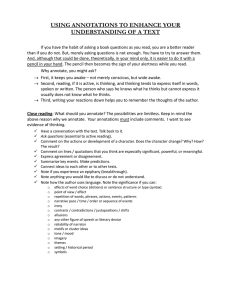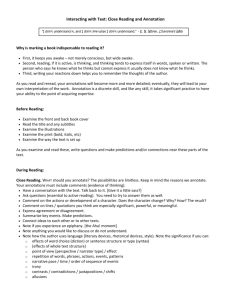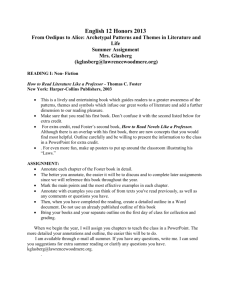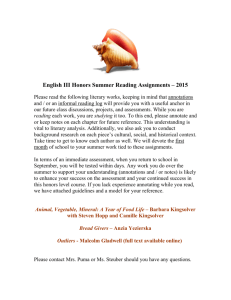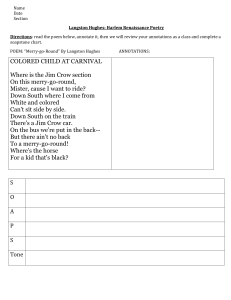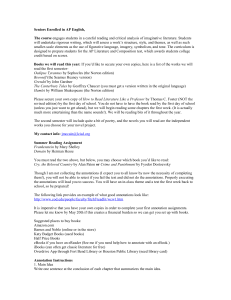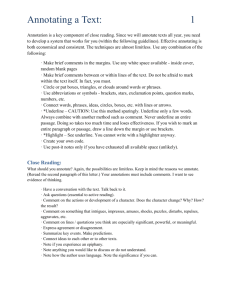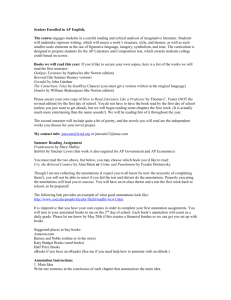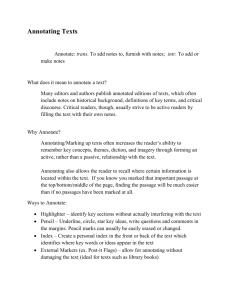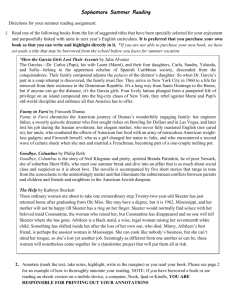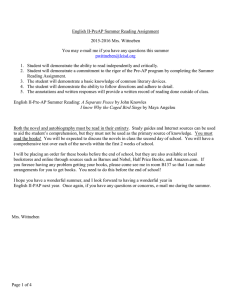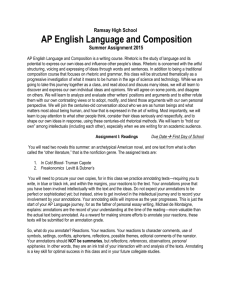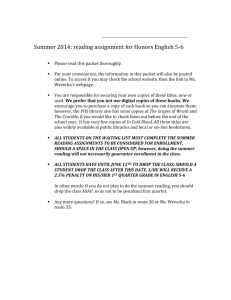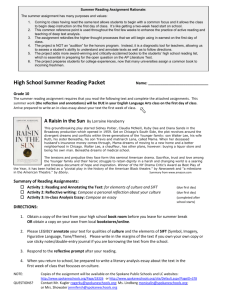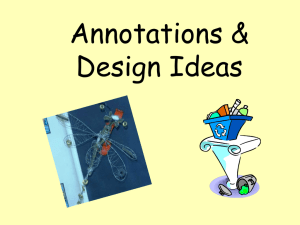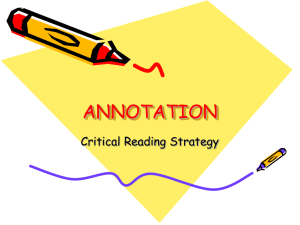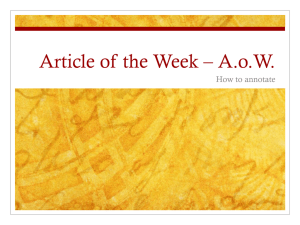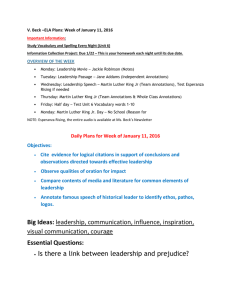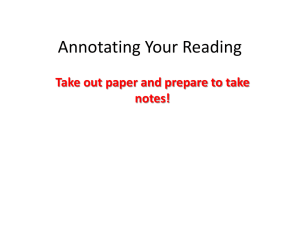Annotating a text - Effingham County Schools
advertisement
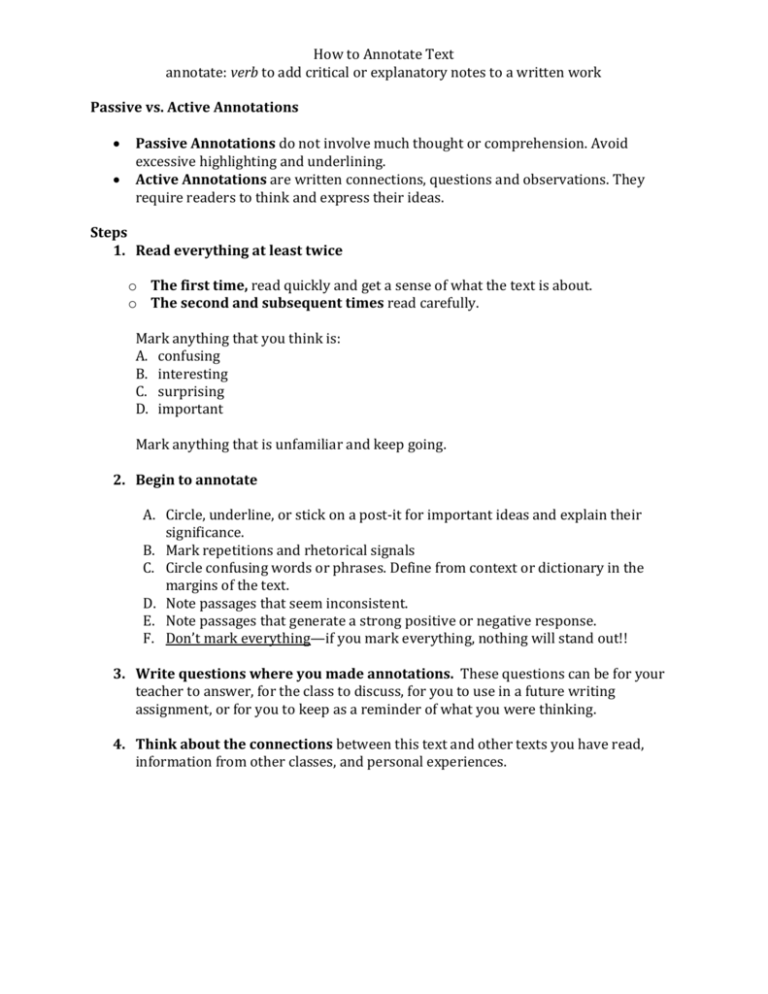
How to Annotate Text annotate: verb to add critical or explanatory notes to a written work Passive vs. Active Annotations Passive Annotations do not involve much thought or comprehension. Avoid excessive highlighting and underlining. Active Annotations are written connections, questions and observations. They require readers to think and express their ideas. Steps 1. Read everything at least twice o The first time, read quickly and get a sense of what the text is about. o The second and subsequent times read carefully. Mark anything that you think is: A. confusing B. interesting C. surprising D. important Mark anything that is unfamiliar and keep going. 2. Begin to annotate A. Circle, underline, or stick on a post-it for important ideas and explain their significance. B. Mark repetitions and rhetorical signals C. Circle confusing words or phrases. Define from context or dictionary in the margins of the text. D. Note passages that seem inconsistent. E. Note passages that generate a strong positive or negative response. F. Don’t mark everything—if you mark everything, nothing will stand out!! 3. Write questions where you made annotations. These questions can be for your teacher to answer, for the class to discuss, for you to use in a future writing assignment, or for you to keep as a reminder of what you were thinking. 4. Think about the connections between this text and other texts you have read, information from other classes, and personal experiences. Tips: Create your own system (within the guidelines) so that this method is useful for you. The techniques are almost limitless. Use any combination of the following: Make brief comments in the margins. Use any white space available – inside cover, random blank pages, etc. Make brief comments between or within lines of the text. Do not be afraid to mark within the test itself. In fact, you must. Circle or put boxes, triangles, or clouds around words or phrases. Use abbreviations or symbols – brackets, stars, exclamation points, question marks, numbers, etc. Connect words, phrases, ideas, circles, boxes, etc. with lines or arrows. Underline – CAUTION : Use this method sparingly. Underline only a few words. Always combine with another method such as comment. Never underline an entire passage. Doing so takes too much time and loses effectiveness. If you wish to mark an entire paragraph or passage, draw a line down the margin or use brackets. Highlight – use CAUTION – don’t highlight everything! Create your own code. Use post-it notes ONLY if you have exhausted all available space (unlikely). Close Reading. What should you annotate? Again, the possibilities are limitless. Keep in mind the reasons we annotate. Your annotations must include comments. I want to see evidence of thinking. Have a conversation with the text. Talk back to it. Ask questions (essential to active reading). Comment on the actions or development of a character. Does the character change? Why? How? The result? Comment on lines / quotations you think are especially significant, powerful, or meaningful. Express agreement or disagreement. Summarize key events. Make predictions. Connect ideas to each other or to other texts. Note if you experience an epiphany. Note anything you would like to discuss or do not understand. Note how the author uses language. Note the significance if you can: effects of word choice (diction) or sentence structure or type (syntax) point of view / effect repetition of words, phrases, actions, events, patterns narrative pace / time / order of sequence of events irony contrasts / contradictions / juxtapositions / shifts allusions any other figure of speech or literary device reliability of narrator motifs or cluster ideas tone / mood imagery themes setting / historical period symbols The most common complaint about annotating is that it slows down your reading. Yes, it does. That’s the point. If annotating as you read annoys you, read a chapter, then go back and annotate. Reading a text a second time is preferable anyway. Approach the works with an open mind. Let them inspire you and stretch your imagination. How to Annotate Literature annotate: Verb [-tating, -tated] to add critical or explanatory notes to a written work [Latin nota mark] Decide on Your Method • Write in the margins if you own the book. • If you don't own the book, sticky notes are good and can also easily be removed. • Finally, you can write on a separate sheet of paper. Be sure to note the page number and passage you are referring to. Passive vs. Active Annotations • Passive Annotations do not involve much thought or comprehension. Avoid excessive underlining and highlighting. • Active Annotations are written connections, questions, and observations. They require readers to think and express their ideas, SIFTT Annotating S – Symbols: A symbol is a literal thing that also stands for something else, like a flag, or a cross, or fire. Symbols help to discover new layers of meaning. I – Imagery: Imagery includes words that appeal to one or more of the five senses. Close attention to imagery is important in understanding an author’s message and attitude toward a subject. F – Figurative Language: Figurative language includes things like similes, metaphors, and personification. Figurative language often reveals deeper layers of meaning. T – Tone: Tone is the overall mood of a piece of literature. Tone can carry as much meaning to the story as the plot does. T – Theme: In literature, a theme is a broad idea in a story, or a message or lesson conveyed by a work. This message is usually about life, society or human nature. Themes explore timeless and universal ideas. Most themes are implied rather than explicitly stated. Types of Annotation • Questions and Answers • Summary of Main Ideas • Character Descriptions • Possible Test Questions • Patterns / Motifs • Personal Connections to Text • Explanations of Text • Marking Important Passages
